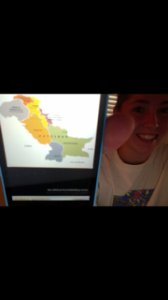Island Emerges in the Arabian Sea

On Tuesday September 24, 2013, a natural phenomenon occurred. An earthquake in northwestern Pakistan caused an island to arise from the seabed off the coast of Gwadar in the Arabian Sea. The magnitude of this earthquake was said to be 7.7, and this force alone allowed for the creation of a new island. The earthquake, killing more than 260 people and injuring numerous others, quickly became a global curiosity.
The island had emerged from the sea only about a kilometer from the shore. The island is estimated to be about 60 to 70 feet high, with a length of 120 feet and a width of 300 feet. Residents from Pakistan were seen taking boats out to the new island and exploring its muddy yet solid rock surface.
While exploring the new island, the sound of escaping gas was heard. When tested if flammable with a match, part of the island set on fire. Not only has an island arose from the sea but it also emits flammable gas. Gas activation is the energy released by the movement of fault-lines which causes gases in the seabed. The seismic activity, vibrations of the earth, due to the earthquake is to blame for the gas activity.
The creation of this island is still a mystery, although scientists claim that this new piece of land could be that of a mud volcano. Seismic activity in the seabed has caused gases to lead to the formation of mud volcanoes. This is further explained by the fact that large earthquakes can cause significant deformation to the earth’s crust. During earthquakes, mud volcanoes release mud and water that was once beneath barriers in the seafloor because of the shaking. The formation of these mud volcanoes is a result of gases from volcanic vibrations on the seabed. When the plates along the fault-lines move, heat is created and the expanding gas is released through the fissures in the earth’s crust which propels the seafloor to the surface.
Even though this extraordinary creation is still being studied, it is not the first time an island has arisen from the seabed. While not unique, a similar island had rose from the sea 60 or 70 years prior in the Arabian Sea. Also, this island off the coast of Gwadar is the fourth to have arisen in the region since 1945. Islands of these sort do not last long. Over time, the formations are either washed away by the sea or are subsided by the pressure easing that once propelled the seafloor onto the surface. To say the least, many scientists believe the island wont last long because the island is merely a pile of mud from the seafloor that was pushed to the surface. The magnitude of the earthquake allowed for this natural occurrence to be fulfilled, although not unique it may come to a surprise to those who have never previously heard of this phenomenon.
While discussing this event with Ipswich High School student Sarah Atkinson, she proclaimed, “I have never heard of such an occurrence like this,” when told about the new island. She further explained that, “I feel as though we students are so ignorant about the world we live in and that we need to become more enlightened by the natural curiosities around us. I never knew that islands emerging from seabeds was not unique, as I have never heard of it. Despite this, I find the reasoning and explanation behind it very interesting.” The earth’s crust was severely deformed on September 24th, and the result is the emergence of this new island.
This event caused distress among scientists and residents searching for an explanation for this occurrence. While not an average event,this comes to a surprise to those who are not informed on the uniqueness of certain natural phenomenons. Pakistan acquired a new piece of land in the form of an island in September, and now the question is, how long will it last?



